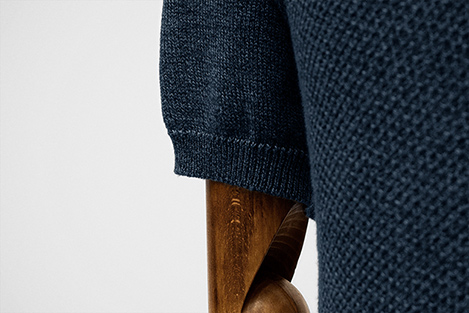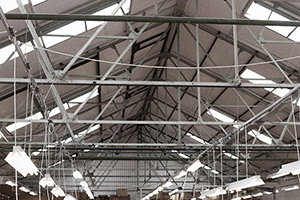Polo shirt in ring-spun cotton in admiral blue
Prices exclude VAT, shipping is free, and orders leave the workshop within three working days.
Shop
£270.00 — ex VAT
Polo shirt, hand-framed with soft ring-spun cotton in the south-west of the British Isles, and dark horn buttons from the West Midlands.
Sizing
The polo shirt fits true to size, and thus the handsome young mannequin — the most standard 40 in all the world — is wearing M.
| XS | S | M | L | XL | |
|---|---|---|---|---|---|
| To fit chest | 36 | 38 | 40 | 42 | 44 |
| Pit-to-pit | 20 | 21 | 22 | 23 | 24 |
| Back length | 23½ | 23¾ | 24 | 24¼ | 24½ |
| Sleeve from centre-back | 17½ | 18 | 18½ | 19 | 19½ |

The polo shirt is made with soft cotton yarn. It is three-ply, mainly, so light enough to be worn under a jacket, but of sufficient substance to be worn with nowt else. It is hand-framed — i.e. made by a single skilled knitter on a hand-operated contraption, which is how things should be but very seldom are.
The polo has in-set sleeves, but with the shoulder seam pushed forward for a smoother line. This is a tell-tale sign of fully fashioned knitwear, which is an approach to knitting wherein each piece of the garment is individually shaped and engineered — tailored, almost — for the best shape and fit.
The sleeves of the polo shirt are noticeably thinner than the body. They are two-ply vs. three. This frees up space for layering the polo with, say, a smart jacket the top. With the very same rationale, the sleeves are also a flat plain-stitch, as opposed to the more textured and chunky tuck-stitch employed elsewhere.
All these parts and panels, all these different weights and textures — it's a good job the knitters responsible are world-leading in hand-linking. Just imagine: every minuscule loop of yarn looped with hand and knitting needle onto the next, to piece the whole thing together. Skilful and strenuous stuff.
The yarn is high-grade 16/2 Ne cotton, combed and spun on traditional ring frames (as in, ring-spun) in Lancashire. It is an uncommonly soft yarn, and makes for a polo shirt which has a warmth to it, thus is comforting on cool days, but is also light and springy to come in useful through summer, too.
The polo has a placket of two horn buttons, which are small of size, tortoiseshell of shading, and matte of finish. Because each button is a thing of nature — rather than an ersatz replica — they are all unique, differing to lesser and greater degrees from one to the next in colour and shade and markings and so on.
There are two shades of soft cotton yarn at play here — two very dark blues. They mingle in the plain-stitch sleeves, and the tuck-stitch of the front and back. The latter is of course the main event. It is a dense stitch, but also springy and breathable. And just look: marvellously textured is the tuck.
As worn
Him, here, is as standard a 38 chest as you could hope to meet. He's wearing a size S in the polo, which seems to fit him about quite well.
Makers of
The garment is hand-framed by a knitwear maker founded 100 years ago. They work with small, hand-operated machines overseen by one person, rather than automated machines, making them one of the last makers still to do so in Britain. It is slow going, but the results always bear out the work put in.
The horn buttons were cut, shaped, and polished by the last such factory in Britain (now defunct). It was part of a tradition in the Midlands first linked to the meat industry of the 18th century. "It is no easy task," said William Hutton in 1780, "to enumerate the infinite diversity of buttons made in Birmingham."



















